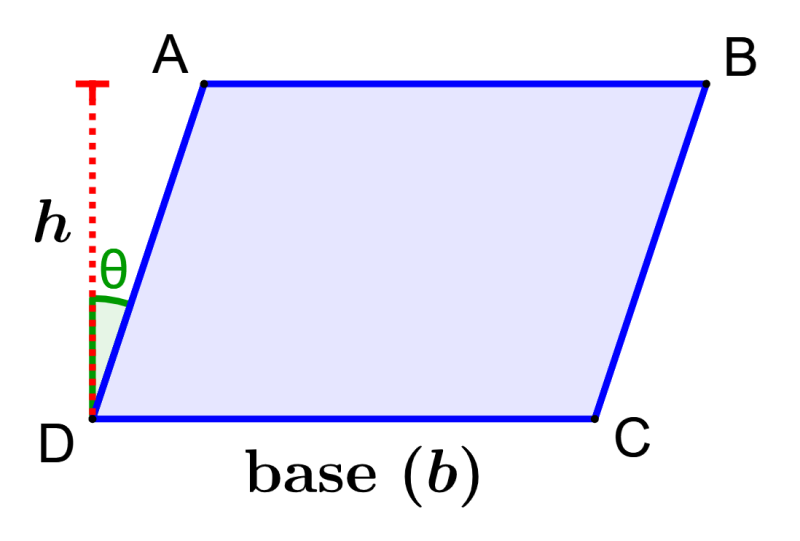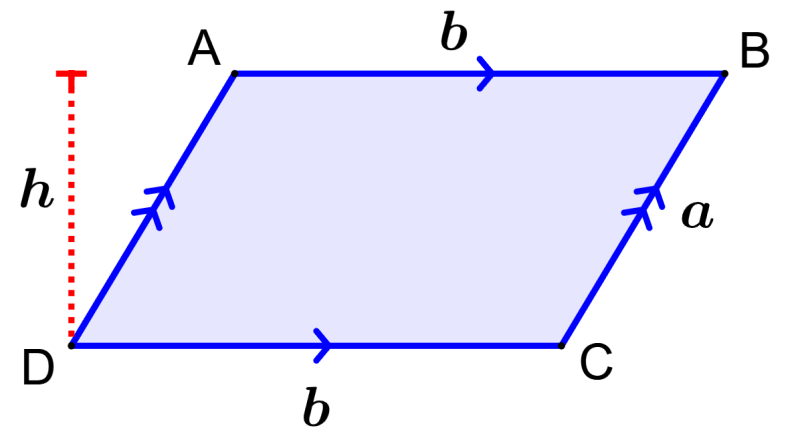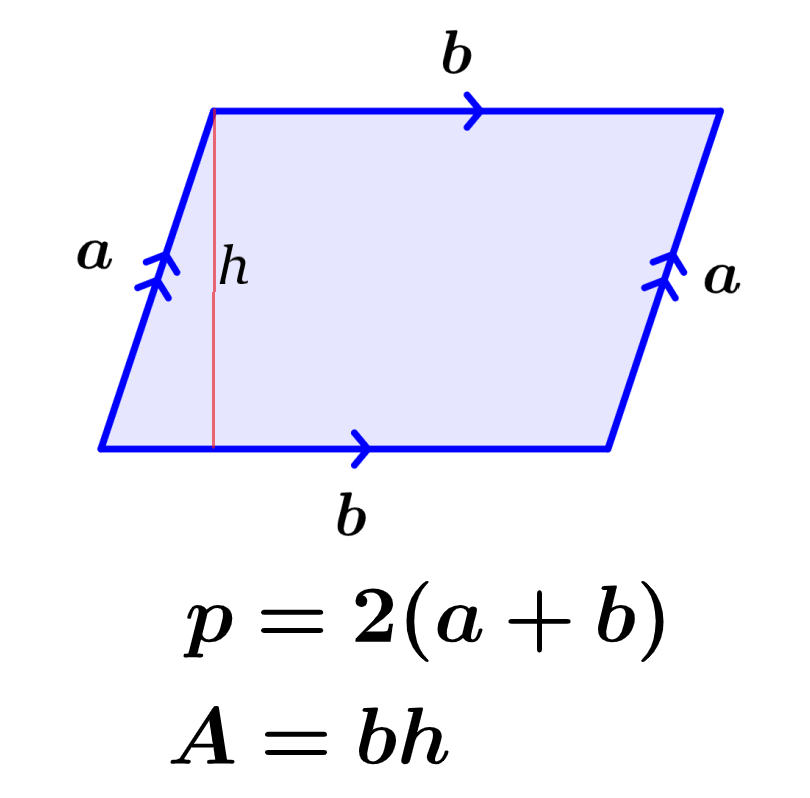The perimeter of a parallelogram represents the length of the contour of the parallelogram. On the other hand, the area is a measure of the two-dimensional space occupied by the figure. We can find the perimeter of the parallelogram by adding the lengths of its four sides, and we can find the area by multiplying the length of its base by its height.
In this article, we will learn all about the perimeter and area of a parallelogram. We will explore its formulas and apply them to solve some practice problems.
How to find the perimeter of a parallelogram?
To find the perimeter of a parallelogram, we have to add the lengths of all its sides. Considering that the opposite sides of a parallelogram have the same length, we can form the following formula:
$latex p=a+b+a+b$
$latex p=2a+2b$
| $latex p=2(a+b)$ |
Calculate the perimeter of a parallelogram with base and height
To calculate the perimeter of a parallelogram using its base and height, we need the angle between its height and its lateral side, as shown in the diagram below.

In a parallelogram, the opposite sides are parallel and equal, and the perimeter of the parallelogram is defined as twice the product of the base and height multiplied by the cosine of the angle:
| $latex p=2(b+h~\cos(\theta))$ |
where, $latex \theta$ is the angle between the height and the lateral side of the parallelogram.
How to find the area of a parallelogram?
To calculate the area of a parallelogram, we can multiply the length of the base by its height. We must consider that the base and the height of the parallelogram are perpendicular to each other, while the lateral side of the parallelogram is not perpendicular to the base.
For example, in the diagram below, we can see that the height of the parallelogram is different from its lateral side:

Therefore, we can use the following formula to find the area of a parallelogram:
| $latex A=bh$ |
where, b is the length of the base and h is the height.
Calculate the area of a parallelogram without using the height
We can calculate the area of a parallelogram without its height if we know the lengths of its sides and the angle between its sides. Therefore, we use the following formula:
| $latex A=ab\sin(x)$ |
where, a and b are the lengths of the sides of the parallelogram and x is the angle between the sides.
Calculate the area of a parallelogram using diagonals
We can calculate the area of a parallelogram when we know the lengths of the diagonals and the angle of intersection of the diagonals. Then, we use the following formula:
| $latex A=\frac{d_{1}\times d_{2}\sin(y)}{2}$ |
where, $latex d_{1}, ~d_{2}$ are the lengths of the diagonals and y is the angle of intersection of the diagonals.
Perimeter and area of a parallelogram – Examples with answers
EXAMPLE 1
Find the perimeter of a parallelogram that has sides with lengths of 8 inches and 12 inches.
Solution
We have the following lengths:
- Side 1, $latex a=8$ in
- Side 2, $latex b=12$ in
Applying the formula for the perimeter with these values, we have:
$latex p=2(a+b)$
$latex p=2(8+12)$
$latex p=2(20)$
$latex p=40$
The perimeter of the parallelogram is equal to 40 in.
EXAMPLE 2
Find the area of a parallelogram that has bases with a length of 12 feet and a height of 11 feet.
Solution
We have the following:
- Base, $latex b=12$ ft
- Height, $latex h=11$ ft
Using the formula for the area with these lengths, we have:
$latex A=bh$
$latex A=(12)(11)$
$latex A=132$
The area of the parallelogram is equal to 132 ft².
EXAMPLE 3
Find the perimeter of a parallelogram that has sides with lengths of 15 yards and 17 yards.
Solution
We have the following:
- Side 1, $latex a=15$ yd
- Side 2, $latex b=17$ yd
Using the formula for the perimeter with these values, we have:
$latex p=2(a+b)$
$latex p=2(15+17)$
$latex p=2(32)$
$latex p=64$
The perimeter of the parallelogram is equal to 64 yd.
EXAMPLE 4
Find the area of a parallelogram that has a base of 15 inches and a height of 20 inches.
Solution
We have the following lengths:
- Base, $latex b=15$ in
- Height, $latex h=20$ in
Using the formula for the area with these lengths, we have:
$latex A=bh$
$latex A=(15)(20)$
$latex A=300$
The area of the parallelogram is equal to 300 in².
EXAMPLE 5
If the perimeter of a parallelogram is equal to 90 inches and one side is equal to 21 inches, how long is the other side?
Solution
We have the following:
- Perimeter, $latex p=90$ in
- Side 1, $latex a=21$ in
In this case, we know the perimeter and we want to find the length of the other side of the parallelogram. Therefore, we use the formula for the formula and solve for the missing side:
$latex p=2(a+b)$
$latex 90=2(21+b)$
$latex 90=42+2b$
$latex 2b=48$
$latex b=24$
The length of the other side is equal to 24 in.
EXAMPLE 6
What is the area of a parallelogram that has sides with lengths of 14 feet and 12 feet and the angle between them is 60°?
Solution
We have the following:
- Side 1, $latex a=14$ ft
- Side 2, $latex b=12$ ft
- Angle, $latex x=60°$
Using the second formula for the area of a parallelogram, we have:
$latex A=ab\sin(x)$
$latex A=(14)(12)\sin(60°)$
$latex A=(168)(0.866)$
$latex A=145.5$
The area of the parallelogram is equal to 145.5 ft².
EXAMPLE 7
Find the perimeter of a parallelogram that has a height of 10 feet and a base of 12 feet if the angle between the height and the lateral side is 60°.
Solution
We have the following:
- Height, $latex h=10$ ft
- Base, $latex b=12$ ft
- Angle, $latex \theta=60°$
We use the second formula for the perimeter, and we have:
$latex p=2(b+h~\cos(\theta))$
$latex p=2(12+10~\cos(60°))$
$latex p=2(12+10(0.5))$
$latex p=2(12+5)$
$latex p=2(17)$
$latex p=34$
The perimeter of the parallelogram is equal to 34 ft.
EXAMPLE 8
A parallelogram has diagonals with lengths of 10 inches and 9 inches. If the angle of intersection of the diagonals is 30°, what is its area?
Solution
We have the following:
- Diagonal 1, $latex d_{1}=10$ in
- Diagonal 2, $latex d_{2}=9$ in
- Angle, $latex y=30°$
Using the third formula for the area with the given information, we have:
$$A=\frac{d_{1}\times d_{2}\sin(y)}{2}$$
$$A=\frac{10\times 9\sin(30°)}{2}$$
$$A=\frac{(90)(0.5)}{2}$$
$$A=\frac{45}{2}$$
$latex A=22.5$
The area of the parallelogram is equal to 22.5 in².
EXAMPLE 9
Find the perimeter of a parallelogram that has a height of 20 yards and a base of 15 yards if the angle between the height and the lateral side is 60°.
Solution
We have the following:
- Height, $latex h=20$ yd
- Base, $latex b=15$ yd
- Angle, $latex \theta=60°$
We use these values in the second perimeter formula, and have:
$latex p=2(b+h~\cos(\theta))$
$latex p=2(15+20~\cos(60°))$
$latex p=2(15+20(0.5))$
$latex p=2(15+10)$
$latex p=2(25)$
$latex p=50$
The perimeter of the parallelogram is equal to 50 yd.
EXAMPLE 10
The area of a parallelogram is equal to 182 in². If its height is 13 inches long, what is the length of its base?
Solution
We have the following values:
- Area, $latex A=182$ in²
- Height, $latex h=13$ in
We use the area formula with the given information and solve for the base, b:
$latex A=bh$
$latex 182=13b$
$latex b=14$
The length of the base is 14 inches long.
Perimeter and area of a parallelogram – Practice problems
See also
Interested in learning more about perimeters and areas of geometric figures? Take a look at these pages:




